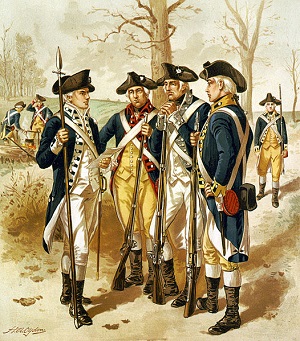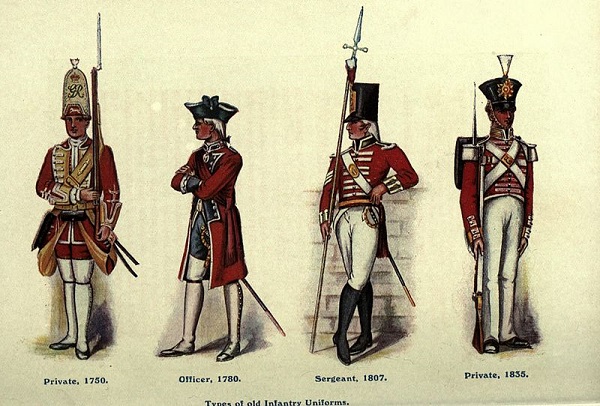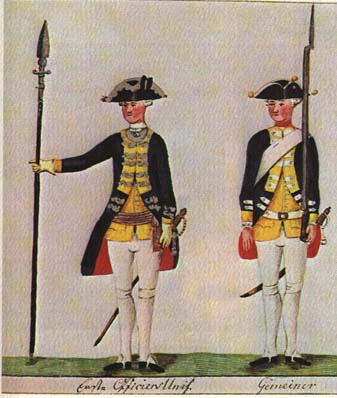The Revolutionary War was fought by American, British and German Hessian soldiers who all had their own unique uniforms and regulations.
Revolutionary War uniforms worn by the Continental Army varied greatly in the early days of the war but eventually became standardized a few years in, although the British Army’s uniforms remained the same throughout.
The following is an overview of the many different types of uniforms of the Revolutionary War:
Continental Army Uniform:
Revolutionary War uniforms prior to 1779 varied greatly. Early in the war, many American soldiers wore long, brown coats.
Starting in 1779, George Washington ordered that uniforms for soldiers in the Continental Army consist of blue coats, white waistcoats and facings of varying colors.
Each state regiment in the Continental army had different colors for the linings, buttons and facings:
New Hampshire, Rhode Island, Connecticut and Massachusetts soldiers wore white facings, linings and buttons.
New York and New Jersey soldiers wore buff facings with white linings and buttons.
Pennsylvania, Delaware, Maryland and Virginia soldiers wore red facings with white linings and buttons.
North Carolina, South Carolina and Georgia soldiers wore blue facings with white linings and buttons.
Light Dragoons wore blue coats with white facings.
According to an article titled “Guide to Military Uniforms” on military.com, the reason blue was chosen for the Continental Army uniforms was because it was in direct contrast to the British Army’s red uniforms.
In addition to the blue coats, the Continental army also wore white, off-white or beige waistcoats, breeches and long-sleeved hunting shirts, black tricorne hats, white stockings and black or dark shoes with buckles.

Uniforms and weapons of the Continental Army, lithograph by Henry Alexander Ogden
According to an article in Soldiers Magazine, in 1782, blue coats with red facings became the standard uniform for all regiments and personnel except generals and staff officers.
Yet, although uniforms were standardized, there continued to be uniform differences due to uniform and clothing material shortages throughout the war, according to a Washington Post article, titled “Revolutionary War uniforms are not so easy to pin down,” by John Kelly:
“Soldiers then wore a rainbow of colors. And the hated British weren’t the only ones in red coats. Some American soldiers wore them, too. One Connecticut regiment had red coats with yellow accents. The 4th New York Regiment had white coats with red accents. The drummers for one New Hampshire regiment had green breeches and canary yellow coats. If they got coats at all. Uniforms were hit and miss, and many soldiers suffered without boots or coats. With no standing army, the Americans sort of made it up as they went along. Nearly every unit was different. Marko has counted 66 styles of uniform between 1775 and 1783, just for Connecticut alone.’That’s one state,’ he says. Many uniforms were modeled after European designs, especially if the commander came from there. Casimir Pulaski ordered fur trim for the uniforms worn by his men. It was what he was used to back home in Poland.”
Rank insignia of the Continental Army 1776-1779:
Each rank in the military had its own rank insignia, which were worn on the officer’s coat to help identify them.
Commanders wore a gold lace epaulet on each shoulder and a light blue sash over the right shoulder.
Major Generals wore a gold lace epaulet on each shoulder and a light purple sash over the right shoulder.
Brigadier Generals wore a gold lace epaulet on each shoulder and a pink sash over the right shoulder.
Colonels wore a gold lace epaulet on each shoulder, a red or pink hat cockade, a red waist sash and a brass hilt sword.
Lieutenant Colonels wore a gold lace epaulet on each shoulder, a red or pink hat cockade, a red waist sash and a brass hilt sword.
Majors wore a gold lace epaulet on each shoulder, a red or pink hat cockade, a red waist sash and a brass hilt sword
Captains wore a gold epaulet on the right shoulder, a yellow, white or buff hat cockade, a red waist sash and a brass hilt sword.
Sub-Alterns wore a gold lace epaulet on the left shoulder, a green hat cockade, a red waist sash and a brass hilt sword.
Sergeants wore a red cloth epaulet on the right shoulder, a red waist sash and an iron hilt sword.
Corporals wore a green cloth epaulet on the right shoulder, a red waist sash and an iron hilt sword.
Privates wore no insignia.
Rank Insignia of the Continental Army 1779-1784:
Commanders wore a gold lace epaulet on each shoulder with 3 silver stars.
Major Generals wore a gold lace epaulet on each shoulder with 2 silver stars.
Brigadier Generals wore a gold lace epaulet on each shoulder with 1 silver stars.
Colonels wore a gold lace epaulet on each shoulder.
Lieutenant Colonels wore a gold lace epaulet.
Majors wore a gold lace epaulet on each shoulder.
Captains wore a gold epaulet on the right shoulder.
Sub-Alterns wore a gold lace epaulet on the left shoulder.
Senior Non-Commissioned Officers wore a red cloth epaulet with brass crescent on each shoulder.
Sergeants wore a red cloth epaulet on the right shoulder.
Corporals wore a green cloth epaulet on the right shoulder.
Privates wore no insignia.
Hat Cockades were black with a white center to commemorate the French alliance with the Americans.
British Army Uniforms:
The uniforms of British soldiers in the Revolutionary War were regulated under the Royal Warrant of 1768. The Royal Warrant declared that the “The King’s, or first colour of every regiment, is to be the Great Union throughout.” The royal red color was intended to make it clear that the soldiers belonged to the king.
British soldiers wore a long red coat with colored facings indicating which regiment the soldier was in, buttonholes trimmed with worsted lace and white buttons. The coat’s skirt had slits that were fastened open to give the soldier more room for movement.

Types of infantry uniforms of the British army, illustration published in Regimental Nicknames and Traditions of the British Army, circa 1916
According to the book Redcoat: The British Soldiers in the Age of Horse and Musket, the 1st royal regiment wore blue facings, the 2nd queens wore sea green facings, the 3rd queens wore buff facings and were called The Buffs, and the 66th wore green facings.
British soldiers also wore white or off-white breeches, white vests, a white shirt, black linen gaiters, black boots and a black cocked hat trimmed with either gold or silver.
Rank Insignia of the British Army:
Corporals wore a white silk epaulette on the right shoulder.
Sergeants wore hats trimmed with silver lace and coats trimmed with plain white lace instead of the regimental pattern. Sergeants also wore a red wool sash with a stripe of the regiment’s facing color woven in the middle.
Officer’s coats and hats were trimmed in either gold or silver metallic lace, depending on their regiment’s designated metal.
Infantry officers wore a metal decorative plate called a gorget, which hung around their neck and was engraved with the King’s arms and the number of their regiment. Officers tied the gorget, which was a vestige of medieval armor, with a silk ribbon of the facing color.
Company-level officers up to captain wore a metallic gold or silver lace epaulette on their right shoulder. Officers above captain, as well as grenadier and light company officers, wore two lace epaulettes.
Officer wore a sash of crimson silk tied around their waist.
Officers of the grenadiers wore fuzils, black bear-skin caps, shoulder-belts, and pouches.
Grenadiers wore round wings of red cloth on the shoulder with six loops of the same color on the buttonholes and on the hem of the coat.
Hessian Uniforms:
German Hessian soldiers wore blue coats and colored facings indicating their regiment. The Jager units of riflemen wore green coats with red facings. The coats and uniforms were made out of a cheap, coarse material similar to burlap.

18th century illustration of Hessian soldiers
Hessian soldiers also wore black boots with a semi-pointed toe, designed to make it easier for the soldier to slip his foot into a stirrup, and a tassel at the top of the boot which fell just below the knee.
For headgear, most Hessians wore the black tricorne hat worn by American troops but Hessian grenadiers wore a tall hat with a brass plate. For weapons, Hessians carried a slender sword called the British Hanger.
If you are researching Revolutionary War uniforms for a class project or Halloween costume, check out the following article on Revolutionary War Soldier Costumes.
Sources:
Franklin, Carl. British Army Uniforms of the American Revolution from 1751-1783. Pen & Sword Books Ltd, 2012.
Burgan, Michael. Weapons, Gear, and Uniforms of the American Revolution. Capstone Press, 2012.
Shaw, Madelyn C. Kathleen A. Staples. Clothing Through American History: The British Colonial Era. Greenwood, 2013.
Collins, Elizabeth M. “Battle Dress Through the Centuries.” Soldiers: The Official US Army Magazine, Secretary of the Army Office of the Chief of Public Affairs, soldiers.dodlive.mil/2015/06/battle-dress-through-the-centuries/
Shenawolf, Harry. “Uniform of the British Army Soldier during the American Revolution by Harry Schenawolf.” Revolutionary War Journal, 1 Feb. 2016, www.revolutionarywarjournal.com/british-army-uniform/
“British Gorget.” Museum of the American Revolution, www.amrevmuseum.org/collection/british-gorget
“Just the Essentials: Clothing and Equipment of Revolutionary War Soldiers.” National Park Service, www.nps.gov/mima/learn/education/upload/essentials.pdf
Kelly, John. “Revolutionary War uniforms are not so easy to pin down.” The Washington Post, 14 April. 2014, www.washingtonpost.com/local/toiling-in-the-library-to-piece-together-the-uniforms-american-soldiers-once-wore/2014/04/14/95065d50-c3db-11e3-b574-f8748871856a_story.html?utm_term=.540a672c7e8a
“Revolutionary War Uniforms.” History of Americans Wars, www.history-of-american-wars.com/Revolutionary-War-Uniforms.html
“Uniforms of the American Revolution.” Boston Tea Party Ships & Museum. Historic Tours of America, www.bostonteapartyship.com/uniforms-of-the-american-revolution
“Index to Uniforms of the American Revolution.” Sons of the Revolution in the State of California, www.srcalifornia.com/uniforms/uindex.htm
“Uniforms.” West Virginia Society Sar, wvssar.org/resources/rev-war/uniforms/
“Red Coat Uniforms, Part 1: Privates and Drummers.” 47th Foot in North America, 9 Feb. 2009, 47thfoot.blogspot.com/search?q=Redcoat+Uniforms%2C+Part+1
“Red Coat Uniforms, Part 2: Corporals, Sergeants and officers.” 47th Foot in North America, 28 Aug. 2012, 47thfoot.blogspot.co.uk/2012/08/redcoat-uniforms-part-2-corporals.html
“1768 Clothing Warrant.” Fife Drum, www.fifedrum.org/crfd/1768.htm
“Just the Essentials: Clothing and Equipment of Revolutionary War Soldiers.” National Park Service, www.nps.gov/mima/learn/education/upload/essentials.pdf

Very useful information.